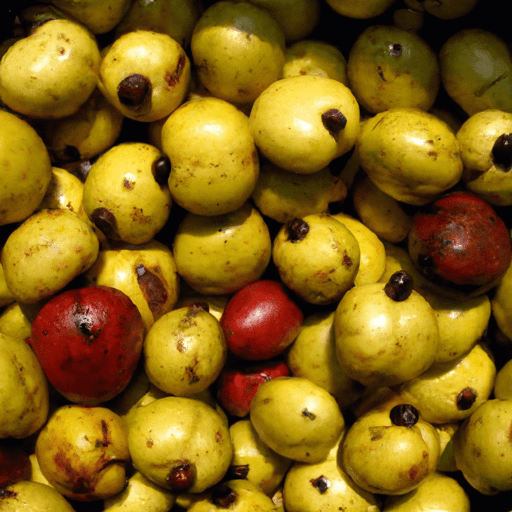Exploring Ackee: The Exotic Jamaican Fruit
Ackee, the national fruit of Jamaica, is a tropical fruit that holds a special place in Caribbean cuisine. Its unique flavor, versatile nature, and intriguing history make it a must-try ingredient for any adventurous food lover. In this article, we’ll dive into the world of ackee, exploring its taste, common uses in cooking, nutritional value, and a few interesting facts along the way.
Taste and Texture
Ackee is often referred to as a fruit, but the edible part is actually the aril, a yellow-colored flesh that surrounds the seed. When fully ripened, the arils open to reveal three distinct, creamy-white lobes. The taste of ackee can be described as rich, buttery, and slightly nutty, with a subtle hint of bitterness. Its creamy texture melts in your mouth, giving a delightful contrast to other ingredients in a dish.
Cooking with Ackee
In Jamaica, ackee is a staple ingredient in many traditional dishes and is often paired with saltfish (codfish). The combination of ackee and saltfish is considered a national Jamaican delicacy, known as “Ackee and Saltfish.” The dish brings together the vibrant colors and flavors of the Caribbean, creating a harmonious blend of textures and tastes.
Aside from being an essential element in this classic Jamaican dish, ackee can be used in various ways in cooking. Its mild flavor and smooth texture make it an excellent addition to stews, curries, omelets, and stir-fried dishes. Ackee can absorb the flavors of other ingredients it’s cooked with, making it a versatile culinary ingredient that complements a range of flavors and spices.
Nutritional Value
Beyond its irresistibly buttery taste and culinary applications, ackee offers several nutritional benefits. It is a good source of vitamins and minerals, including vitamin C, vitamin A, potassium, and magnesium. Additionally, ackee contains healthy fats, fiber, and protein. Consuming ackee can contribute to a well-rounded and nutritious diet, providing essential nutrients to support overall health and wellness.
However, it’s important to note that the unripe fruit contains hypoglycin A, a toxin that can cause a serious illness called Jamaican vomiting sickness if consumed improperly. Therefore, it is crucial to ensure that ackee is properly ripe and cooked before being consumed.
Interesting History and Facts
The story of ackee is intertwined with Jamaican history and culture. Ackee trees are native to West Africa and were brought to the Caribbean during the transatlantic slave trade. The fruit flourished in Jamaica’s tropical climate and quickly became an integral part of the island’s cuisine.
In fact, ackee was once a symbol of resistance and rebellion against slavery. The fruit’s scientific name, Blighia sapida, pays tribute to Captain William Bligh, a British navigator who introduced ackee to English soil. Bligh played a significant role in bringing ackee to Jamaica and the world, forever leaving his mark on the fruit’s historical significance.
Today, ackee remains deeply ingrained in Jamaican culture and continues to captivate taste buds around the globe. Its unique flavor and cultural significance make it a true culinary gem that’s worth exploring.
So, the next time you come across ackee, don’t hesitate to experiment with this exquisite fruit. Whether you’re savoring it in the traditional “Ackee and Saltfish” or incorporating it into your own culinary creations, ackee is sure to add a touch of Caribbean flair to your dishes. Embrace the taste of the tropics and let the adventure begin!
Ackee
Origin: Ackee (Blighia sapida) is a tropical fruit that is native to West Africa, particularly Ghana and Ivory Coast. It was brought to the Caribbean in the 18th century during the slave trade and is now considered a popular fruit in Jamaica.
Common Uses: In Jamaica, ackee is a key ingredient in the national dish, “Ackee and Saltfish.” The fruit is boiled and then sautéed with salted codfish, onions, tomatoes, and spices. It has a buttery, creamy texture and is often compared to scrambled eggs in terms of taste and consistency. Ackee is also used in other Caribbean dishes, such as ackee soup, ackee patties, and ackee and rice.
Nutritional Benefits: Ackee is a good source of vitamin C, vitamin B6, and dietary fiber. It also contains some minerals, including potassium, magnesium, and phosphorus. However, it should be noted that ackee also contains hypoglycin A and hypoglycin B, which can be toxic if the fruit is not harvested and prepared properly. The fruit must be fully ripened and the toxic arils removed before consumption.
Unique Properties: One interesting characteristic of ackee is that it has bright red arils (fleshy seeds) that are usually the only edible part. The arils are surrounded by a yellow or cream-colored spongy pulp, which is discarded. Ackee is also unique in that it naturally splits open when it is ripe and ready to be harvested.
Historical Significance: Ackee has a fascinating historical significance in Jamaica. It is believed that slaves brought the fruit with them from West Africa, and it eventually became an important staple in Jamaican cuisine. In fact, ackee was granted national fruit status in Jamaica in 1992, highlighting its cultural and historical importance.




Use the share button below if you liked it.
It makes me smile, when I see it.